Back to Don's Maps
 Back to Archaeological Sites
Back to Archaeological Sites
 Back to the review of hominins
Back to the review of hominins
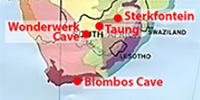 Hominid sites in Africa, including Homo sapiens
Hominid sites in Africa, including Homo sapiens
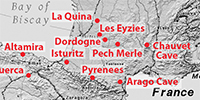 Hominid sites in Europe, including Homo sapiens
Hominid sites in Europe, including Homo sapiens
Hominid sites in Africa and nearby regions
Hominids or Hominins?
The most commonly used recent definitions are:
Hominid – the group consisting of all modern and extinct Great Apes (that is, modern humans, chimpanzees, gorillas and orang-utans plus all their immediate ancestors).
Hominin – the group consisting of modern humans, extinct human species and all our immediate ancestors (including members of the genera Homo, Australopithecus, Paranthropus and Ardipithecus).
Definition above: https://australianmuseum.net.au/
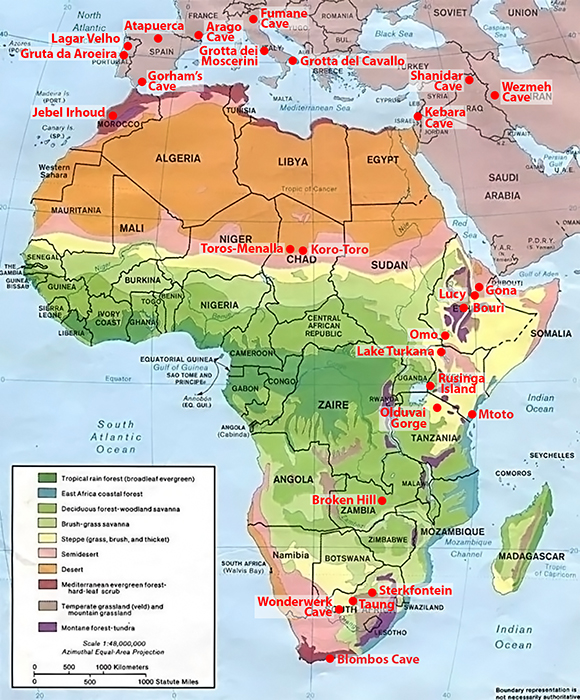
Map of important Hominid sites in Africa and nearby regions.
Click on the map to obtain the high resolution version.
Base Map: NCpedia
Proximal Source: https://www.ncpedia.org/media/map/map-africa-showing
Permission: ![]() This work has been released into the public domain
This work has been released into the public domain
Additional text in red: Don Hitchcock
| Important Hominid sites in Africa | |||
|---|---|---|---|
| Map Reference | Comment | Linked Image | Text and Link |
| Arago Cave |
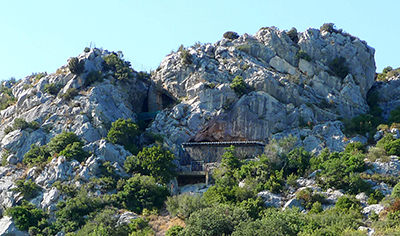 Excavations since 1964 have revealed a number of human fossils at Arago including a skull and jaw from different individuals. Homo erectus and Homo heidelbergensis fossils have been found. |

|
Tautavel Man (Homo erectus tautavelensis), is a proposed subspecies of the hominin Homo erectus, the 450 000 years old fossil remains of whom were discovered in the Arago Cave in Tautavel, France. Excavations began in 1964, with the first notable discovery occurring in 1969. The skeletal remains of two individual hominins have been found in the cave: a female older than forty (Arago II, July 1969), and a male aged no more than twenty (Arago XXI, July 1971, and Arago XLVII, July 1979). Recovered stone tools originate from within a 5 kilometres radius of the cave, while animal bones suggest the inhabitants could travel up to 33 kilometres for food. See: Homo erectus tautavelensis |
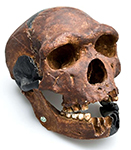
|
Arago 21 and Arago 13, a skull and lower jaw of Homo heidelbergensis were discovered in Arago Caves, Tautavel, France. Excavations since 1964 have revealed a number of human fossils at Arago, as well as thousands of stone tools. The bones of many types of animals have also been uncovered at this site.
See: Homo heidelbergensis |
||
| Atapuerca |
 Fossils from the Gran Dolina railway cut in northern Spain's Sierra Atapuerca are from a hitherto unknown species of early human, Homo antecessor (from the Latin for pioneer or explorer), circa 780 000 BP, and claim that it is directly ancestral to both modern humans and Neanderthals. |

|
The Gran Dolina fossils--nearly 80 postcranial, cranial, facial, and mandibular bones as well as teeth of at least six individuals - were excavated between 1994 and 1996. A key specimen is a partial facial skeleton of a juvenile, estimated to be ten to eleven years old, recovered in 1995. The fossils exhibit both seemingly modern features, such as sunken cheekbones with a horizontal rather than vertical ridge where upper teeth attach and a projecting nose and midface, and more primitive ones, including prominent brow ridges and premolars with multiple roots. ( The Australian museum at https://australianmuseum.net.au notes that although many experts consider these remains to be part of an early and variable Homo heidelbergensis population, the discoverers believe the fossils are different enough to be given the new species name Homo antecessor - Don ) See: Homo antecessor |
| Blombos Cave |
 The excavations at Blombos Cave have yielded important new information on the behavioural evolution of anatomically modern humans, Homo sapiens. The archaeological record from this cave site has been central in the ongoing debate on the cognitive and cultural origin of early humans and to the current understanding of when and where key behavioural innovations emerged among Homo sapiens in southern Africa during the Late Pleistocene. |

|
Archaeological material and faunal remains recovered from the Middle Stone Age phase in Blombos Cave – dated to circa 100 000 - 70 000 BP – are considered to represent greater ecological niche adaptation, a more diverse set of subsistence and procurements strategies, adoption of multi-step technology and manufacture of composite tools, stylistic elaboration, increased economic and social organisation and occurrence of symbolically mediated behaviour.
See: Homo sapiens |
| Bouri |
 The type specimen of Australopithecus garhi (BOU-VP-12/130) is a partial cranium discovered in 1997 by Yohannes Haile-Selassie in Bouri, Ethiopia. Its brain size was about 450 cm3, similar to other australopithecines. Body size and shape were probably slightly larger than Australopithecus afarensis. The skeletal remains were found associated with antelope bones bearing cut marks, apparently from stone tools. Stone tools were not found at this site, but at the nearby, contemporaneous site Gona. These are the earliest dated stone tools that have been found, but may have been left by another species. |
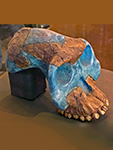
|
Australopithecus garhi had very large canines, molars and premolars, thick tooth enamel, and a rectangular or U-shaped dental arcade diastema (the gap between canines and incisors) often present in the upper jaw. This is a primitive feature. Like many australopithecines, including some Australopithecus afarensis, it had a sagittal crest for anchoring large jaw muscles.A changing climate had thinned the forests that once dominated this region, and savannah grasslands were becoming widespread. It most likely ate plant material and possibly some meat. If the antelope bones found at the site were butchered by this species, then they must have included significant amounts of meat and marrow in their diet. See: Australopithecus garhi |
| Broken Hill |
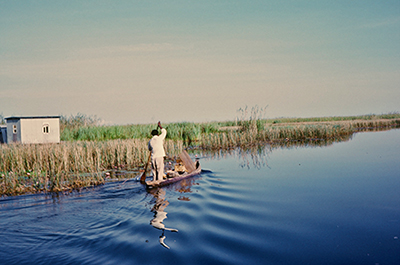 A skull of Homo heidelbergensis discovered by T. Zwigelaar in 1921 at Kabwe (formerly Broken Hill), Zambia, was the first fossil of a human ancestor to be discovered in Africa. |
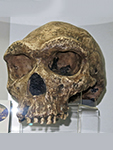
|
The BH1 skull combines primitive features such as a wide face, thick arching brow ridges and a sloping forehead with a large brain capacity of 1280 cubic centimetres. This individual had significant tooth decay and a number of associated abscesses had decayed the upper jaw bone.
Later hominins than Homo erectus from Africa, Europe and Asia that lived between about 600 000 and 1 million years ago, like Homo heidelbergensis, continue the trends seen in earlier forms. They are characterised by larger brains, faces and teeth, with more robust bodies. They hunted a wide variety of game and entered various new environments not occupied by previous hominids. Their stone tools were still Acheulian hand axes and flakes, and their camp sites were simple and appear not to have been used repeatedly. See: Homo heidelbergensis |
| Fumane Cave |
 A fossil marine shell, Aspa marginata, was discovered in a Mousterian layer of Fumane Cave, northern Italy, and was dated to 47 600 cal BP. Analysis shows that this fossil gastropod was collected by Neanderthals, at a Miocene or Pliocene fossil outcrop, the closest of which is located more than one hundred kilometres from the site. |
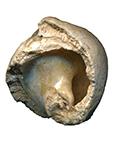
|
The shell was smeared with a pure, finely ground, hematite powder, probably mixed with a liquid. It was perhaps perforated and used as a personal ornament before being discarded, lost or intentionally left at Fumane Cave, some 47 600 - 45 000 cal BP. The minimum age of the Fumane unit in which the Aspa marginata was found predates the oldest available dates for the arrival of anatomically modern humans (AMH) in Europe, thus supporting the hypothesis that deliberate transport and colouring of exotic objects, and perhaps their use as pendants, was a component of Neanderthal cultures.
See: Neanderthal painted shell |
| Gona |
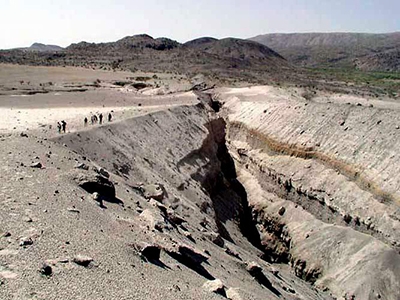 |
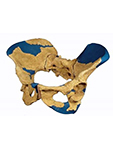
|
A Homo erectus fossil found at Gona, Afar, Ethiopia, suggests that females had large, wide pelvises in order to deliver large-brained babies. Being born with a larger brain meant our ancestor became independent far more quickly than modern human infants. The new finding, published in Science magazine, conflicts with earlier ideas that suggest they had a tall, thin body shape adapted for running. Homo erectus is thought to be the first human-like creature to move out of Africa to colonise the world. This now extinct hominin species may also have been the first to control fire.
See: Homo erectus |
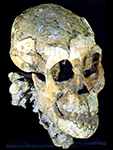
|
The stunningly complete skeleton of a three-year-old girl who lived 3.3 million years ago, often called 'Lucy's Baby' was uncovered at Dikika near Gona, Ethiopia, an area known as the Middle Awash Valley. The child belongs to the species Australopithecus afarensis like the famous 'Lucy', who was discovered in 1974. The young age of the so-called Dikika child, now called 'Selam' promises new insights into the growth of early humans. The find is the most complete and important skeleton of an immature Pliocene hominin ever found. See: Australopithecus afarensis |
||

|
Ardipithecus kadabba at 10.6° N, 40.6° E, near Gona. Middle Awash Valley, Ethiopia, 5 800 000 BP - 5 200 000 BP, discovered in 1997. Ape-like build similar to modern chimpanzee in both size and build, large canines, human-like features include lack of canine honing and large molars, as well as a big toe bone that suggests bipedalism. See: Ardipithecus kadabba |
||

|
Ardipithecus ramidus - A partial skeleton found in 1994, consisting of about 125 pieces, was described and published in 2009. The individual, from circa 4 500 000 BP - 4 300 000 BP was found west of the Awash River, in Aramis, Ethiopia, and is believed to be a female, and has been nicknamed 'Ardi'. She weighed about 50kg and stood about 120cm tall. The skeleton does not look much like a chimp or gorilla nor have the expected 'transitional' features. Instead, it may well preserve some of the characteristics of the last chimp-human ancestor. Analysis of the skeleton reveals that humans did not evolve from knuckle-walking apes, as was long believed. Ardipithecus ramidus , unlike modern hominids, has adaptations for both walking on two legs (bipedality) and life in the trees (arboreality). However, it would not have been as efficient at bipedality as humans, nor at arboreality as non-human great apes. See: Ardipithecus ramidus |
||
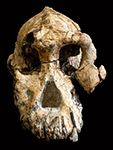
|
About 3.8 million years ago, Australopithecus anamensis, a distant human relative, took his final steps. Swept into a river delta, his head was buried in sand that, over time, hardened into a stone helmet. The skull fossilised within the sandstone, to the delight of the scientists who discovered the cranium in 2016. Excavations at Woranso-Mille in Ethiopia, the site of an ancient river and lake system where anthropologists found the fossil, have produced a trove of bones from ancient primates. The primates sported a mixture of traits both primitive and humanlike. The species almost certainly walked on two legs, yet they had long arms and strong hands, suggesting they were capable climbers. The fossil is now at the National Museum in Addis Ababa, Ethiopia. See: Australopithecus anamensis |
||
| Gorham's Cave |
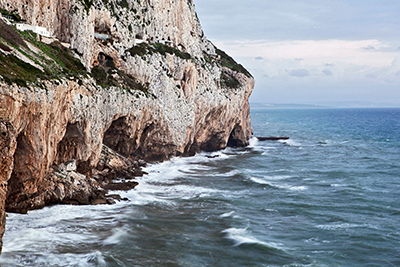 Forbes' Quarry, close by Gorham's Cave, was also inhabited by Neanderthals, and we have a skull from that site. |

|
Excavation of this site has resulted in the discovery of four layers of stratigraphy. Level I has produced evidence for eighth to third centuries BC use by Phoenicians. Below that, level II produced evidence for brief Neolithic use. Level III has yielded at least 240 Upper Paleolithic artefacts of Magdalenian and Solutrean origin. Level IV has produced 103 items, including spear-points, knives, and scraping devices that are identified as Mousterian, and shows repeated use over thousands of years.
See: Homo neanderthalensis |
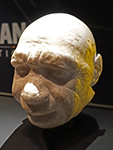
|
Forbes' Quarry was the site of the 1848 discovery of the first Neanderthal skull by Lieutenant Edmund Flint of the Royal Artillery. The fossil, an adult female skull, is referred to as Gibraltar 1 or the Gibraltar Skull. Although it was discovered before the hominin from the Neander Valley, this was not recognised at the time, so the Neander Valley hominin became the type specimen. See: Homo neanderthalensis |
||
| Grotta del Cavallo |
 |

|
The cave contains a rich stratigraphic succession with a depth of 7 m that is deposited on top of an interglacial beach foundation. The most notable section of this sequence covers the Middle Palaeolithic, associated with the Neanderthal Mousterian culture and recently discovered subsequent strata that were associated with the earliest known appearance of anatomically modern humans in Europe.
See: Homo neanderthalensis |
| Grotta dei Moscerini |
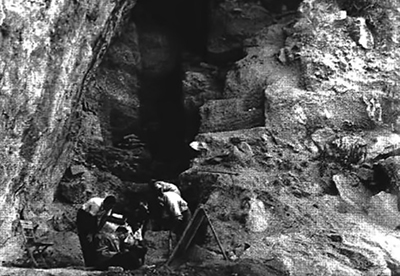 |

|
Grotta dei Moscerini is one of two Italian Neanderthal sites with a large assemblage of retouched shells (n = 171) from 21 layers. The other occurrence is from the broadly contemporaneous layer L of Grotta del Cavallo in southern Italy (n = 126). Eight other Mousterian sites in Italy and one in Greece also have shell tools but in a very small number. The shell tools are made on valves of the smooth clam Callista chione. At Moscerini 23.9% of the specimens were gathered directly from the sea floor as live animals by skin diving Neanderthals.
See: Homo neanderthalensis |
| Gruta da Aroeira |
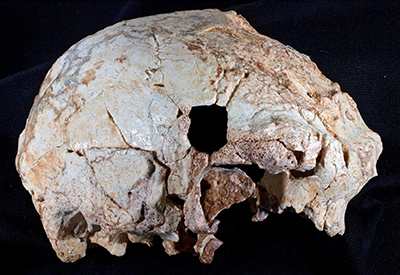 |
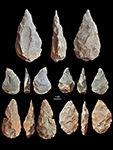
|
The cranium represents the westernmost human fossil ever found in Europe during the middle Pleistocene epoch and one of the earliest on this continent to be associated with the Acheulean stone tool industry. In contrast to other fossils from this same time period, many of which are poorly dated or lack a clear archaeological context, the cranium discovered in the cave of Aroeira in Portugal is well-dated to 400 000 years ago and appeared in association with abundant faunal remains and stone tools, including numerous bifaces (handaxes).
See: Homo heidelbergensis |
| Jebel Irhoud |
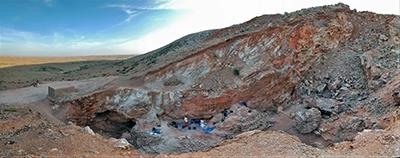 |
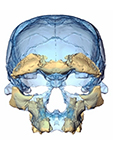
|
Researchers from the Max Planck Institute for Evolutionary Anthropology (MPI-EVA) in Leipzig found the remains of at least five people, including three young adults, a teenager and a child, in years of excavations there, around 100 kilometres northwest of Marrakech. This is what the research team around the palaeoanthropologist Jean-Jacques Hublin reports in the current issue of the journal 'Nature'. The ancestors found now were very similar to us. Above all, their faces largely corresponded to that of today's people. 'The ancestors from Djebel Irhoud would hardly be noticed in a crowd today with a hat on,' says Hublin. Her brain was also about the same size as that of modern humans, only the shape of the back of the head was slightly different. The Djebel Irhoud people had a less round, slightly elongated skull and probably also a smaller cerebellum than we do. The brain of Homo sapiens has evolved gradually since then, says Hublin, and it has become increasingly networked and organised. See: Homo sapiens |
| Kebara Cave |
 The deposit at Kebara Cave has two important components, Middle Palaeolithic Aurignacian and Mousterian, and Epi-Paleolithic Natufian. First occupied about 60 000 years ago, the 4 metre thick cave deposit has Levallois stone artefacts, as well as many hearths and midden deposits. It is believed that the Homo sapiens fossils found at Qafzeh Cave, 45 km from Kebara Cave, are from an early migration out of Africa by modern humans around 125 000 years ago. When this occurred, they must have encountered Neanderthal groups who were already living there. |
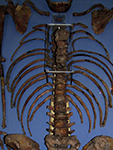
|
The oldest occupations at Kebara Cave are thought to be associated with the Middle Palaeolithic Aurignacian and Mousterian traditions, and range between 60 000 and 48 000 years ago. These oldest levels yielded thousands of animal bones - primarily mountain gazelle and Persian fallow deer - many of the bones with cutmarks, as well as burned bones, hearths, ash lenses and lithic artefacts leading researchers to believe Kebara Cave was a long-term occupied base camp for its Neanderthal residents.
See: Homo neanderthalensis |

|
This Homo sapiens child, from Qafzeh Cave, Israel, was about 13 years old when he or she died. Their skull was found in a burial site with red deer antlers placed on the body. Intentional burial has also been documented in the Neanderthals. The site is from 90 000 - 120 000 years BP
See: Homo sapiens |
||
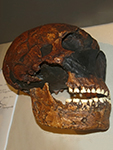
|
Amud 1 is a nearly complete but poorly preserved adult Neanderthal skeleton thought to be circa 50 000 years old. It was discovered at Amud near the Sea of Galilee in Israel by Hisashi Suzuki in July 1961, who described it as male. With an estimated height of 178 cm, it is considerably taller than any other known Neanderthal, and its skull has by far the largest cranial capacity (1736 - 1740 cm3 ) of any archaic hominin skull ever found, making it one of the most famous specimens of Neanderthal skulls.
See: Homo neanderthalensis |
||
| Koro-Toro |
 Australopithecus bahrelghazali is the only Australopithecus found outside East Africa. Found at Koro-Toro, It is named after the Bahr-el-Ghazal oasis in Chad. Dated circa 3 500 000 BP. |
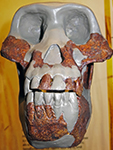
|
The validity of Australopithecus bahrelghazali has not been widely accepted, in favour of classifying the specimens as Australopithecus afarensis. Australopithecus afarensis is a better known Pliocene australopithecine from East Africa, and the doubts over naming are because of the anatomical similarity and the fact that Australopithecus bahrelghazali is known only from 3 partial jawbones and an isolated premolar. See: Australopithecus bahrelghazali |
| Lake Turkana |
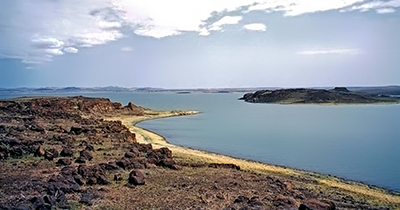 |
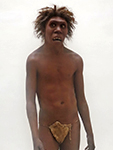
|
The most famous Homo erectus find is the 'Turkana Boy', KNM WT 15000, a young male discovered on the bank of the Nariokotome River near Lake Turkana in Kenya by Kamoya Kimeu in 1984. 1.6 - 1.5 million years old.
See: Homo erectus |

|
Paranthropus boisei / Australopithecus boisei, KNM-ER 406, 1 700 000 BP is an adult male with an estimated cranial capacity of 510 cc, from Koobi Fora, Kenya. KNM-ER 406 is a nearly complete adult male Paranthropus boisei. It has the facial and cranial features typical of the species such as massive cheek teeth, and the widely flaring zygomatic arches with a forward placed connection to the other facial bones, and large cheek bones supported powerful chewing muscles - the latter two features giving it a 'dish-shaped' face. Other muscles extended from his jaw to the sagittal crest at the top of his head. The cranial capacity of this skull has been estimated at 510 cc. Koobi Fora refers primarily to a region around Koobi Fora Ridge, located on the eastern shore of Lake Turkana. The ridge itself is an outcrop of mainly Pliocene/Pleistocene sediments. It is composed of claystones, siltstones, and sandstones that preserve numerous fossils of terrestrial mammals, including early hominin species. See: Paranthropus boisei |
||
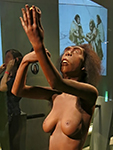
|
Another Homo erectus from the same area is the female KNM-ER 3733, found at Koobi Fora, Kenya, on the eastern shore of Lake Turkana, by Bernard Ngeneo, a field worker for Richard Leakey.
See: Homo erectus |
||
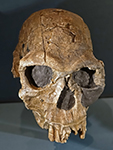
|
Homo habilis, KNM ER-1813,
1 900 000 BP, Koobi Fora, Kenya. This 1 900 000 year old skull was discovered in 1973 by Kamoya Kimeu at Koobi Fora, East Turkana, Kenya. This adult skull has a brain size of only 510 cubic centimetres, which is only just above the average for species placed in the Australopithecus genus. See: Homo habilis |
||

|
Homo rudolfensis,
Lake Turkana, Kenya, 1 900 000 BP. Discovered by B. Ngeneo, 1972KNM-ER 1470, PA EM 4407).
In comparison with Homo habilis, this species had a somewhat larger cranial capacity, a flatter face and forward-facing cheekbones. It is also associated with stone tools. The key specimen of this species is skull KNM-ER 1470. When it was discovered by Richard Leakey's team in 1972 at Koobi Fora, it was not attributed to a species, only to a member of the genus Homo. In 1986, a Russian anthropologist gave the skull the species name Pithecanthropus rudolfensis. The genus name of Pithecanthropus was later dropped and replaced with Homo. The species name rudolfensis comes from the location where the type specimen KNM-ER 1470 was found - Lake Rudolf, now known as Lake Turkana, Kenya. Fossils have been found in Urhara, Malawi, and Lake Turkana. See: Homo rudolfensis |
||
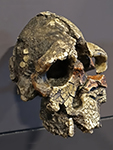
|
Kenyanthropus platyops, 3 500 000 BP - 3 200 000 BP,
was discovered at Lake Turkana, Kenya by Justus Erus, who was part of Meave Leakey's team. Fragments of a skull (KNM-WT 40000) and teeth were found in 1999 and reconstructed. Another specimen tentatively classified into this species is a partial left upper jaw (KNM-WT 38350) which was discovered in 1998. The finders believe the skull shares similarities with a later species, Homo rudolfensis, including the relatively flat face and the lack of a depression behind the brow ridge, indicating it may be an ancestor of Homo. See: Kenyanthropus platyops |
||
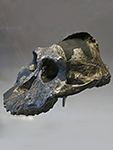
|
Paranthropus aethiopicus, KNM-WT 17000, was found on the western shore of Lake Turkana in Kenya by Kamoya Kimeu in 1984.
It was originally named Australopithecus boisei, but was found to be the same species as an earlier find at Omo, Ethiopia, just over the border from Lake Turkana, and since this had been named
Paraustralopithecus aethiopicus it was eventually given the name Australopithecus boisei. The terms Australopithecus and Paranthropus are interchangeable. The specimen KNM-WT 17000 is known as the 'Black Skull' due to the dark colouration of the bone, caused by high levels of manganese in the deposit. Paranthropus aethiopicus, circa 2 500 000 BP. has notable features that differ from the other robust australopithecines, including a larger zygomatic arch, extended ramus of the mandible, and a more prognathic face. Paranthropus aethiopicus is considered a megadont archaic hominin, the term megadont referring to the huge size of the postcanine tooth crowns. The initial discovery was a toothless adult mandible in the Shungura formation of the Omo region of Ethiopia in 1967 (Omo 18.18). The ash layers above and below the fossils give an approximate date of 2 500 000 BP - 2 300 000 BP. See: aethiopicus.html |
||
| Lagar Velho |
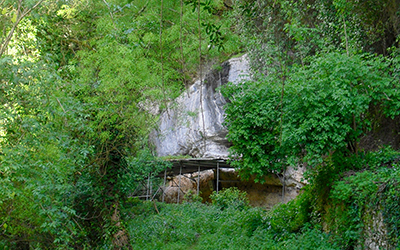 |
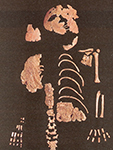
|
A 24 000-year-old early modern human child burial known as The Lapedo child was discovered at Lagar Velho. The cranium, mandible, dentition, and postcrania appear to present a mosaic of European early modern human and Neanderthal features, although this interpretation is disputed.
See: Homo neanderthalensis x sapiens |
| Lucy |
 |
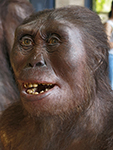
|
The most famous fossil is the partial skeleton named Lucy (3.2 million years old) found in the Hadar region by Donald Johanson and colleagues, who, in celebration of their find, repeatedly played the Beatles song Lucy in the Sky with Diamonds.
See: Australopithecus afarensis |
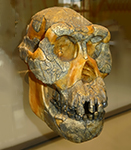
|
Australopithecus afarensis - 3 900 000 BP - 2 800 000 BP, A.L. 442-2, Hadar, Ethiopia. This skull of this male is much bigger than the skull of Lucy and other females of this species, indicating that there was sexual dimorphism in this hominin. See: Australopithecus afarensis |
||
| Mtoto |
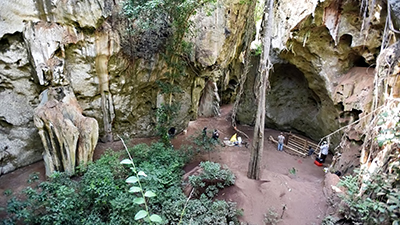 |
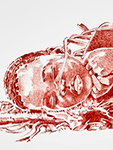
|
Researchers who studied the fragile, ancient remains described how its head appeared to have been laid on a pillow. Scientists have named the child Mtoto, meaning 'child' in Swahili. The researchers were able to study the teeth to confirm that this was the tiny body of a human child - between two and three years old. Scans revealed that the body had been laid in a fetal position, and the bones had moved in a way that suggested it had been wrapped tightly when buried, with its head originally resting on something like a cushion of leaves, which subsequently decomposed. See: Homo sapiens |
| Olduvai Gorge |
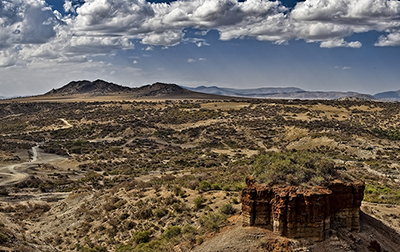 The site is significant in showing the increasing developmental and social complexities in the earliest humans, or hominins, largely revealed in the production and use of stone tools. Homo habilis, probably the first early human species, occupied Olduvai Gorge approximately 1.9 million years ago (mya); then came a contemporary australopithecine, Paranthropus boisei, 1.8 mya, followed by Homo erectus, 1.2 mya. Our species Homo sapiens, which is estimated to have emerged roughly 300 000 years ago, is dated to have occupied the site 17 000 years ago. |
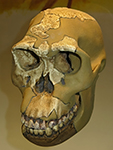
|
Homo habilis was a species of the tribe Hominini, which lived between roughly 2.1 and 1.5 million years ago. The type specimen is OH 7, discovered in 1960 at Olduvai Gorge in Tanzania, associated with the Oldowan lithic industry. The image shown at left is of ‘Twiggy’, OH 24, a skull discovered in 1968 by Peter Nzube in Olduvai Gorge. When found, this skull had been badly crushed and was reconstructed from hundreds of fragments. See: Homo habilis |

|
Paranthropus boisei was an early hominin, described as the largest of the Paranthropus genus (robust australopithecines). It lived in Eastern Africa during the Pleistocene epoch from about 2.3 until about 1.2 million years ago. First discovered by Mary Leakey in 1959, at Olduvai Gorge, Tanzania, the well-preserved cranium (nicknamed 'Nutcracker Man') was dated to 1.75 million years old and had characteristics distinctive of the robust australopithecines. Her son Richard Leakey considered it to be the first hominin species to use stone tools.
See: Paranthropus boisei |
||
| Omo |
 |
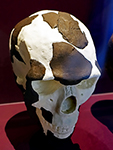
|
Early Homo sapiens - with its high, rounded braincase, this is one of the oldest modern human fossils found so far. Along with modern human skulls discovered in Herto, Ethiopia, it suggests that East Africa was a key area in the emergence of modern humans.
See: Homo sapiens |
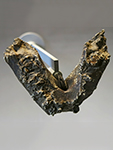
|
Paranthropus aethiopicus / Australopithecus aethiopicus, type specimen, OMO 18-1967-18, circa 2 600 000 BP. This lower jaw was discovered in 1967 by Camille Arambourg and Yves Coppens at the Omo River location, Omo Valley, Ethiopia. Lower jaw and teeth fragments have been uncovered. Paranthropus aethiopicus had a large sagittal crest and zygomatic arch adapted for heavy chewing (as in gorilla skulls). See: Paranthropus aethiopicus |
||
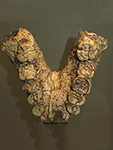
|
Paranthropus boisei, lower jaw, Omo, Ethiopia, L7a-125 Circa 2 200 000 BP. See: Paranthropus boisei |
||
| Rusinga Island |
 |
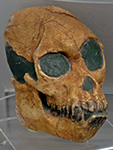
|
The palaeontologist Louis Leakey, who was one of the foremost fossil-hunters of the 20th century and a champion of evolution, said:
'An especially important creature was Proconsul africanus. This, many authorities once concluded, gave us an indication of the common stock for apes and men. We have good forelimb bones for it, and in 1948 on Rusinga Island Mary [Leakey] discovered a skull, the first nearly complete specimen ever found. Its canine teeth suggest an ape's, while its forehead reminds us of our own. It seems to me, however, to be neither an ancestral ape, nor yet an ancestor of man, but a side branch with characteristics of both stocks...'
Leakey changed his mind a few times about the exact classification of Proconsul, as did most other palaeontologists. Opinion currently favours a position between the monkeys and the apes. See: Proconsul africanus |
| Shanidar Cave |
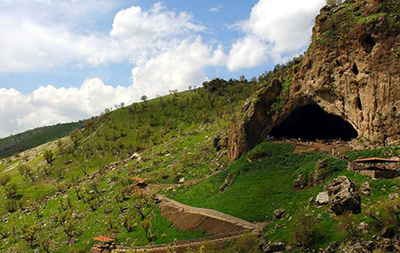 |
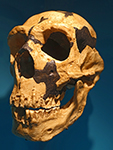
|
The excavated area produced nine skeletons of Neanderthals of varying ages and states of preservation and completeness (labelled Shanidar I - IX, or Shanidar 1 - 9). A tenth individual was recently discovered by M. Zeder during examination of a faunal assemblage from the site at the Smithsonian Institution. The remains seemed to Zeder to suggest that Neanderthals had funeral ceremonies, burying their dead with flowers, and that they took care of injured individuals.
See: Homo neanderthalensis |
| Sterkfontein |
 The area was the site of the discovery of the circa 3 500 000 BP year old fossil Australopithecus africanus (nicknamed 'Mrs. Ples'), found in 1947 by Robert Broom and John T. Robinson. The find helped corroborate the 1924 discovery of the juvenile Australopithecus africanus skull known as the 'Taung Child', by Raymond Dart, at Taung in the North West Province of South Africa, where excavations still continue. Nearby, but not in the site, the Rising Star Cave system contains the Dinaledi Chamber (chamber of stars), in which were discovered fifteen fossil skeletons of an extinct species of hominin, provisionally named Homo naledi. Sterkfontein alone has produced more than a third of early hominid fossils ever found prior to 2010. The Dinaledi Chamber contains over 1 500 Homo naledi fossils, the most extensive discovery of a single hominid species ever found in Africa. |

|
At Sterkfontein Cave, R. Broom and J.T. Robinson found in 1947 what they called 'Mrs Ples', an Australopithecus africanus fossil which Broom classified as Plesianthropus transvaalensis. It was dubbed Mrs. Ples by Broom's young coworkers (though the skull is now thought to have belonged to a young male). It was later reclassified as Australopithecus africanus and is identified by the catalog number as STS 5. They used dynamite to free the skull from the stone in which it was entombed, which is why there is a missing piece on the forehead. Anthropologists now take a lot more time and care to free specimens from the matrix they are found in. See: Australopithecus africanus |
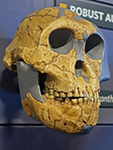
|
At Kromdraai the type specimen of Australopithecus/Paranthropus robustus was found. At Drimolen Main Quarry, DNH 7, or 'Eurydice' was discovered, which is the most complete skull of Paranthropus robustus ever found. In the cave at Swartkrans, the remains of 130 individuals were discovered. The study made on the dentition of the hominins revealed that the average Paranthropus robustus rarely lived past 17 years of age. Swartkrans is the site where the fossilised partial cranium and palate of Australopithecus / Paranthropus robustus, SK 46 was discovered by local quarrymen and Robert Broom in 1949, and the SK-48 cranium was discovered by Fourie, a local quarryman, in 1950. See: Australopithecus/Paranthropus robustus at Swartkrans, Kromdraai and Drimolen Main Quarry |
||
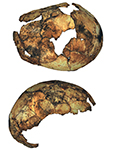
|
At the same site, the oldest known Homo erectus was found. The discoveries at Drimolen Main Quarry offer evidence that Homo erectus trekked from the bottom of South Africa, across the African continent and into the Caucasus region within only a couple of hundreds of thousands of years.
See: Homo erectus, at Drimolen Main Quarry |
||

|
Homo naledi is a previously unknown species of extinct hominin discovered within the Dinaledi Chamber of the Rising Star cave system, also part of the Cradle of Humankind.
See: Homo naledi, within the Rising Star cave system |
||
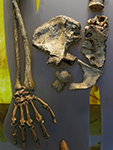
|
Australopithecus sediba - The first specimen was found by palaeoanthropologist Lee Berger's nine-year-old son, Matthew, in 2008 at the Malapa Nature Reserve. The fossil turned out to belong to a 1270 mm tall juvenile male, whose missing skull was discovered in March 2009 by Berger's team. Also found at the Malapa archeological site were a variety of animal fossils, including sabre-toothed cats, mongooses, and antelopes. Berger and geologist Paul Dirks speculated that the animals might have fallen into a deep 30 m - 46 m 'death-trap', perhaps lured by the scent of water. See: Australopithecus sediba, at Malapa |
||
| Taung |
 |
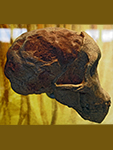
|
The Taung Child is believed to have been about three years old at the time of its death. It was a creature standing 105 cm tall, weighing 9-11 kg. See: Australopithecus africanus |
| Toros-Menalla |
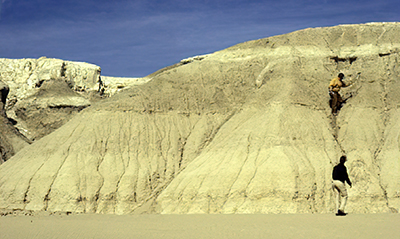 |
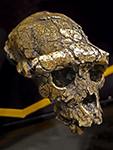
|
This may be the earliest hominin. This species probably lived close to the time human ancestors and the ancestors of other apes split on the family tree. Like us, it had small canines and a flat face. However, it had a thick brow ridge and a small brain, more like a chimpanzee. See: Sahelanthropus tchadensis |
| Wezmeh Cave |
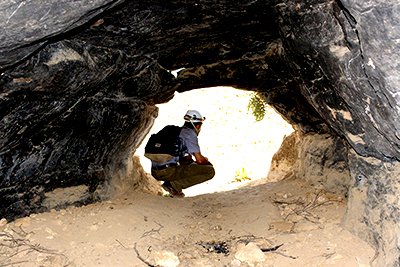 |

|
The tooth was found with large numbers of animal fossil remains in a cave site called Wezmeh near Islamabad Gharb, western Iran, around 470 km southwest of the capital Tehran. The site was discovered in 1999. See: Homo neanderthalensis |
| Wonderwerk Cave |
 |

|
Rock art occurs in the form of parietal paintings within the first 40 m from the entrance of Wonderwerk Cave, possibly all less than 1000 years old, and small engraved stones found within the deposit, mainly from the Later Stone Age sequence where they date back some 10 500 years.
The Acheulean, an archaeological industry of stone tool manufacture characterised by distinctive oval and pear-shaped 'hand-axes' associated with Homo erectus and derived species such as Homo heidelbergensis is represented in Wonderwerk Cave. See: Wonderwerk Cave |
References
- Berger et al., 2015: Homo naledi, a new species of the genus Homo from the Dinaledi Chamber, South Africa, eLife 2015;4:e09560, DOI: 10.7554/eLife.09560
- Currat M., Excoffier L., 2004: Modern Humans Did Not Admix with Neanderthals during Their Range Expansion into Europe, PLOS Biology, 2 (12): e421. doi:10.1371/journal.pbio.0020421. PMC 532389. PMID 15562317.
- Higham T., 2021: The world before us, Viking, Penguin Random House UK, 320 pp., ISBN 9780241440674.
- Lumley A., 2015: L’homme de Tautavel. Un Homo erectus européen évolué. Homo erectus tautavelensis, L'Anthropologie, Volume 119, Issue 3, June–August 2015, Pages 303-348
- van den Bergh G. et al., 2016: Homo floresiensis-like fossils from the early Middle Pleistocene of Flores, Nature, 534 (7606): 245–248. doi:10.1038/nature17999. PMID 27279221.
Back to Don's Maps
 Back to Archaeological Sites
Back to Archaeological Sites